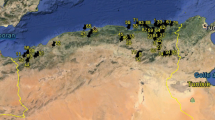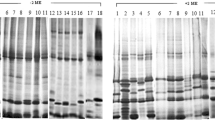Summary
Endosperm protein components from common bread wheats (Triticum aestivum L.) and related species were extracted with aluminum lactate, pH 3.2, and examined by electrophoresis in the same buffer. Electrophoretic patterns of the albumins and globulins were compared to evaluate the possibility that a particular species might have contributed its genome to tetraploid or hexaploid wheat. Together with protein component mobilities, differential band staining with Coomassie Brilliant Blue R250 was employed to test the identity or non-identity of bands. Eight species and 63 accessions, representative of Triticum and Aegilops were tested. Considerable intraspecific variation was observed for patterns of diploid but not for tetraploid or hexaploid species. Patterns of some accessions of Triticum urartu agreed closely with major parts of the patterns of Triticum dicoccoides and T. aestivum. A fast-moving, green band was found in all accessions of T. urartu and of Triticum boeoticum, however, that was not found in those of T. dicoccoides or T. aestivum. This band was present in all accessions of Triticum araraticum and Triticum zhukovskyi. Patterns of Aegilops longissima, which has been suggested as the donor of the B genome, differed substantially from those of T. dicoccoides and T. aestivum. Finally, two marker proteins of intermediate mobility were also observed and may be used to discriminate between accessions of T. araraticum/T. zhukovskyi and those of T. dicoccoides/T. aestivum.
Similar content being viewed by others
Literature
Boyd, W.J.R.; Lee, J.W.; Wrigley, C.W.: The D-genome and the control of wheat gluten synthesis. Experentia 25, 317–319 (1969)
Chapman, V.; Miller, T.E.; Riley, R.: Equivalence of the A genome of bread wheat and that of Triticum urartu. Genet. Res., 27, 69–76 (1976)
Charbonnier, L.: Isolation of ω-gliadin. C.Rend. Acad. Sci. (Paris) 271D, 2042–2045 (1970)
Dronzek, B.L.; Kaltsikes, P.J.; Bushuk, W.: Effect of the D genome on the protein of three cultivars of hard red spring wheat. Can. J. Plant Sci. 50, 389–400 (1970)
Elton, G.A.H.; Ewart, J.A.D.: Starch-gel electrophoresis of cereal proteins. J. Sci. Food Agric. 13, 62–72 (1962)
Graham, J.S.D.: Starch-gel electrophoresis of wheat flour proteins. Austr. J. Biol. Sci. 16, 342–349 (1963)
Hall, O.: Immuno-electrophoretic analyses of allopolyploid rye wheat and its parental species. Hereditas 45, 495–504 (1959)
Hall, O.; Johnson, B.L.: Electrophoretic analysis of the amphiploid Stipa viridula × Oryzopsis hymenoides and its parental species. Hereditas 48, 530–535 (1963)
Johnson, B.L.; Hall, O.: Analysis of phylogenetic affinities in the Triticinae by protein electrophoresis. Am. J. Bot. 52, 506–513 (1965)
Johnson, B.L.: Tetraploid wheats: seed protein electrophoretic patterns of the emmer and timopheevi groups. Science 158, 131–132 (1967)
Johnson, B.L.; Barnhart, D.; Hall, O.: Analysis of genome and species relationships in the polyploid wheats by protein electrophoresis. Am. J. Bot. 54, 1089–1098 (1967)
Johnson, B.L.: Seed protein profiles and the origin of the hexaploid wheats. Am. J. Bot. 59, 952–960 (1972)
Johnson, B.L.: Seed protein patterns and the gene resources of heat. Proc. Symp. Genetics and Breeding of durum wheat, 153–164 (1973)
Johnson, B.L.: Identification of the apparent B-genome donor of wheat. Can. J. Genet. Cytol. 17, 21–39 (1975)
Kimber, G.; Athwal, R.S.: A reassessment of the course of evolution of wheat. Proc. Natl. Acad. Sci. U.S.A. 69, 912–915 (1972)
Kihara, H.: Discovery of the DD analyzer, one of the ancestors of Triticum vulgare. Agric. Hort. 19, 889–890 (1944)
Konarev, V.G.; Gavrilyuk, I.P.; Peneva, T.I., Konarev, A.V.; Khakimova, A.G.; Migushova, E.F.: Nature and origin of wheat genomes, based on data from biochemistry and immunochemistry of wheat proteins. Sel.-Khoz. Biol. 11, 656–665 (1976)
Lee, J.W.; Ronalds, J.A.: Effect of environment on whcat gliadin. Nature 213, 844–846 (1967)
McFadden, E.S.; Sears, E.R.: The artificial synthesis of Triticum spelta. Rec. Genet. Soc. Am. 13, 26–27 (1944)
Minetti, M.; Petrucci, T.; Pocchiari, F.; Silano, V.; Avella, R.: Varietal differences in water-soluble gliadin fractions of Triticum aestivum and of Triticum durum seeds. J. Sci. Food Agric. 22, 72–74 (1971)
Minetti, M.; Petrucci, T.; Cattaneo, S.; Pocchiari, F.; Silano, V.: Studies of the differential staining of wheat albumins, globulins, and gliadins in polyacrylamide gel by aniline blue-black. Cereal Chem. 50, 198–209 (1973)
Morris, R.; Sears, E.R.: The cytogenetics of wheat and wheat relatives. In: Wheat and Wheat Improvements (eds. Quisenberry, K.S.; Reitz, L.P.) pp. 19–87. Am. Soc. Agron.: Madison, Wisconsin 1967
Riley, R.; Unrau, J.; Chapman, V.: Evidence on the origin of the B genome in wheat. J. Hered. 49, 91–98 (1958)
Sarkar, P.; Stebbins, G.L.: Morphological evidence concerning the origin of the B genome in wheat. Am. J. Bot. 43, 297–304 (1956)
Sears, E.R.: The B-genome of Triticum. Wheat Info. Serv. 4, 8–10 (1956)
Shepherd, K.W.: Chromosomal control of endosperm proteins in wheat and rye. Proc. 3rd. Int. Wheat Genet. Symp., 86–96 (1968)
Silano, V.; deCillis, V.; Pocchiari, F.: Varietal differences in albumin and globulin fractions of Triticum aestivum and T. durum. J. Sci. Food Agric. 20, 260–261 (1969)
Vardi, A.: Introgression between different ploidy levels in the wheat group. Proc. 4th Int. Wheat Genet. Symp., 131–141 (1973)
Vittozzi, L.; Silano, V.: The phylogenesis of protein α-amylase inhibitors from wheat seed and the speciation of polyploid wheats. Theor. Appl. Genet. 48, 279–284 (1976)
Wrigley, C.W.; Shepherd, K.W.: Identification of Australian wheat cultivars by laboratory procedures: examination of pure samples of grain. Austr. J. Exp. Agric. 14, 796–810 (1974)
Zohary, D.; Feldman, M.: Hybridization between amphidiploids and the evolution of polyploids in the wheat (Aegilops-Triticum) group. Evolution 16, 44–61 (1962)
Author information
Authors and Affiliations
Additional information
Communicated by J. Mac Key
Rights and permissions
About this article
Cite this article
Caldwell, K.A., Kasarda, D.D. Assessment of genomic and species relationships in Triticum and Aegilops by PAGE and by differential staining of seed albumins and globulins. Theoret. Appl. Genetics 52, 273–280 (1978). https://doi.org/10.1007/BF00303505
Received:
Issue Date:
DOI: https://doi.org/10.1007/BF00303505




